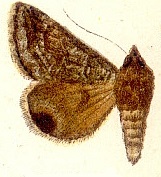
Mongolia is a landlocked country in East Asia, bordered by Russia to the north and China to the south. It covers an area of 1,564,116 square kilometres, with a population of just 3.3 million, making it the world's most sparsely populated sovereign state. Mongolia is the world's largest landlocked country that does not border a closed sea, and much of its area is covered by grassy steppe, with mountains to the north and west and the Gobi Desert to the south. Ulaanbaatar, the capital and largest city, is home to roughly half of the country's population.
This article details the fixtures and results of the Chinese Taipei national football team.

Drasteria is a genus of moths in the family Erebidae.

Drasteria cailino is a moth of the family Erebidae first described by Alexandre Louis Lefèbvre de Cérisy in 1827. It is found in southern Europe, the Near East and Middle East up to the western Himalayas in the east. In the Levant, several isolated populations are present in Lebanon, Syria and Israel.
Drasteria flexuosa is a moth of the family Erebidae first described by Édouard Ménétries in 1847. It is found in the semi-deserts and deserts from eastern Egypt, to Israel, Jordan, Syria, Kazakhstan, China, Mongolia and Afghanistan.
Drasteria aberrans is a moth of the family Erebidae. It is found in central Asia.
Drasteria rada is a moth of the family Erebidae. It is found in Ukraine, southern Russia, Kazakhstan, Turkey, Georgia, Armenia, Iran, Kyrgyzstan, Mongolia and China.
Drasteria antiqua is a moth of the family Erebidae. It is found in Kyrghyzstan and Mongolia.
Drasteria catocalis is a moth of the family Erebidae. It is found in Kyrghyzstan, Kazakhstan, Tajikistan, China, Uzbekistan and Russia.

Drasteria caucasica is a moth of the family Erebidae. It is found in Romania, north-eastern Bulgaria, southern Moldova, southern Ukraine, Russia, Kazakhstan, Turkey, Daghestan, Armenia, Iraq, Iran, Turkmenistan, Uzbekistan, Tajikistan, Afghanistan, Pakistan, Kyrghyzstan, China and Mongolia.
Drasteria chinensis is a moth of the family Erebidae. It is found in Kyrgyzstan, Kazakhstan, Mongolia and China (Gansu).
Drasteria mongoliensis is a moth of the family Erebidae found mostly in Russia (Siberia) and Mongolia.

Drasteria pulverosa is a moth of the family Erebidae. It is found in Russia and Mongolia.

Drasteria picta is a moth of the family Erebidae first described by Hugo Theodor Christoph in 1877. It is found in Ukraine, Russia, Kazakhstan, southern Turkey, Syria, Armenia, Daghestan, Kyrgyzstan, Uzbekistan, Turkmenistan, Mongolia and China.
Drasteria saisani is a moth of the family Erebidae. It is found in Crimea and in southern Russia, Armenia, Kazakhstan, Uzbekistan, Kyrgyzstan, Tajikistan, Turkmenistan, Daghestan, Turkey, Iran, Afghanistan, Pakistan and China.
Drasteria scolopax is a moth of the family Erebidae. It is found in China and Russia (Siberia).

Drasteria sesquistria is a moth of the family Erebidae. It is found in Russia, Kazakhstan, Afghanistan, Uzbekistan, Tajikistan, Kyrgyzstan, Turkmenistan and Mongolia.

Drasteria tenera is a moth of the family Erebidae. It is found in Russia, Kazakhstan, Kyrgyzstan and China (Tibet).







